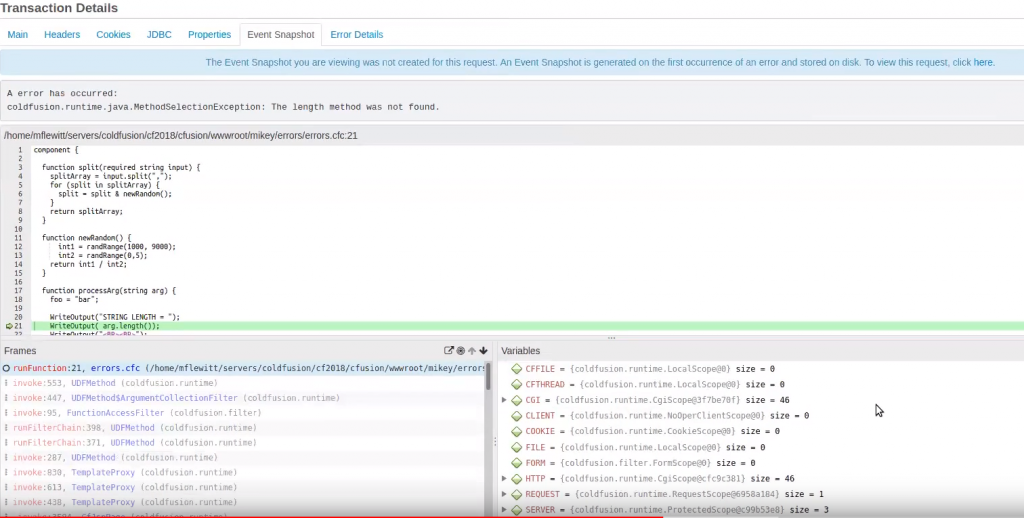Nosuchfielderror: finding, avoiding, and fixing
What is a Nosuchfielderror?
NoSuchFieldError is a less common error that occurs when a Java program tries to access a field that does not exist in a class or interface. This error can happen when a class is updated, a field is removed, or when a class is moved to a different package, and its package-private fields are no longer accessible. This blog post will discuss how to avoid this error, find the root cause, and use an Application Performance Management (APM) tool to help identify and diagnose the problem.
How do I avoid a NoSuchFieldError?
One way to avoid this error is to ensure that the field that is being accessed exists in the class or interface. This can be done by checking the Java documentation or the class’s source code to ensure that the field is present and accessible.
Another way to avoid this error is to use a tool like FindBugs or PMD, which can analyze your code and detect potential NoSuchFieldError issues before they occur.
How do I find a NoSuchFieldError?
To find the root cause of this error, you can check the error’s stack trace to see which class and field is causing the problem. The stack trace will show the line of code where the error occurred, along with the name of the class and the field that caused the error.
Here is an example of the error message:
java.lang.NoSuchFieldError: fieldName at MyClass.main(MyClass.java:15)
In this example, the error occurred in the “main” method of the “MyClass” class, and the problem is that “fieldName” does not exist in the class.
How do I find a NoSuchFieldError using an APM tool?
FusionReactor is an Application Performance Management (APM) tool that can be used to diagnose NoSuchFieldError problems. An Application Performance Monitoring (APM) tool can help you find a NoSuchFieldError by monitoring the performance of an application and identifying any issues that may be causing problems. Here are a few ways in which an APM tool can help you:
Exception tracking: Many APM tools allow users to track exceptions within an application; the stack trace usually indicates which field and class is causing NoSuchFieldError.
Code analysis: Some APM tools provide the ability to analyze the code of an application and identify potential issues, such as missing fields or incorrect field references. This can help you detect NoSuchFieldError before they occur.
Thread dump analysis: APM tools can provide the thread dump of the application, which can be useful for identifying which thread is causing the problem and the operation that is being executed. This can be useful for identifying where in the code the NoSuchFieldError is occurring.
Performance metrics: Some APM tools can provide performance metrics for your application, such as CPU usage, memory usage, and response time. This can be useful for identifying performance bottlenecks that may contribute to the NoSuchFieldError.
Log monitoring: APM tools can also provide the ability to log all the activities of the application, which can be useful for identifying when and where the NoSuchFieldError occurred.
Find the root cause of a NoSuchFieldError using FusionReactor Event Snapshot
Event Snapshots provide deep insight when there is a problem, such as an exception or thread latency. Snapshots are triggered automatically. In addition to displaying the source code, scope variables, stack trace, and logging information, you’ll also have all the information you need to solve the problem quickly and efficiently.
Conclusion – Nosuchfielderror: finding, avoiding, and fixing
In conclusion, NoSuchFieldError is an error that occurs when a Java program tries to access a field that does not exist in a class or interface. To avoid this error, ensure that the accessed field exists in the class or interface, or use a tool like FindBugs or PMD to detect potential issues. To find the root cause of this error, check the stack trace to see which class and field are causing the problem. To fix this error, add the missing field to the class, update the code to no longer reference the missing field, or update the code to reference the field with its fully-qualified name. An Application Performance Management (APM) tool can help identify and diagnose NoSuchFieldError issues by providing exception tracking, code analysis, thread dump analysis, performance metrics, and logging, which can help identify and locate the source of the problem.




